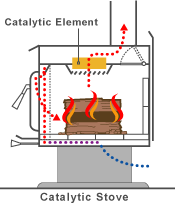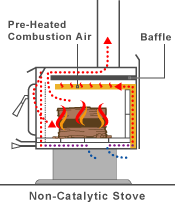
Choosing an efficient wood stove
 I've
recently come to the conclusion that there are two ways of being green
--- the Prius method and the penny-pinching method. Followers of
the Prius method spend a lot of money to buy the most expensive model,
not realizing that the increased efficiency they're paying for could be
obtained just as easily (and much more cheaply) by downsizing a
bit. For example, my 20+ year old Ford Festiva has gas mileage
nearly compatible with the Prius for a fraction of the up-front cost
(and a fraction of the construction cost since my Festiva has already
been on
the road for two decades.)
I've
recently come to the conclusion that there are two ways of being green
--- the Prius method and the penny-pinching method. Followers of
the Prius method spend a lot of money to buy the most expensive model,
not realizing that the increased efficiency they're paying for could be
obtained just as easily (and much more cheaply) by downsizing a
bit. For example, my 20+ year old Ford Festiva has gas mileage
nearly compatible with the Prius for a fraction of the up-front cost
(and a fraction of the construction cost since my Festiva has already
been on
the road for two decades.)
Which is all a way
of saying that there are two ways to buy a very
energy
efficient wood stove.
Followers of the Prius method will
jump on a catalytic wood stove, an innovation that will lower their
emissions and increase their burning efficiency. On the negative
side, catalytic wood stoves are extremely expensive, and the catalyst
will have to be replaced in two to six years, which has environmental
repurcussions and makes a deep dent in your pocketbook.
 Middle of the road wood stove
buyers will gravitate to Energy Star
non-catalytic wood stoves. The use of baffles, firebox
insulation, and preheated combustion air combine to make these wood
stoves nearly as efficient as the catalytic versions and at least 60%
more efficient than old-fashioned wood stoves. Like the catalyst
in a catalytic wood stove, the baffle in a non-catalytic wood stove may
need to be replaced from time to time, but my understanding is that
this replacement is considerably less expensive.
Middle of the road wood stove
buyers will gravitate to Energy Star
non-catalytic wood stoves. The use of baffles, firebox
insulation, and preheated combustion air combine to make these wood
stoves nearly as efficient as the catalytic versions and at least 60%
more efficient than old-fashioned wood stoves. Like the catalyst
in a catalytic wood stove, the baffle in a non-catalytic wood stove may
need to be replaced from time to time, but my understanding is that
this replacement is considerably less expensive.
Then there's the
penny-pinching route, which I'm seriously
considering. Even the most efficient wood stoves only burn at
peak efficiency if you keep your fire hot, and the smallest Energy Star
wood stoves seem to clock in at about 60,000 BTU. Although it's
only a rough guide, many sources suggest planning on 50 to 55 BTU per
square foot in the extreme north of the U.S., 30 to 35 BTU per square
foot in the deep south, and around 40 to 45 BTU per square foot here in
southwest Virginia. Using those numbers, we should be in the
market for a 20,000 to 22,500 BTU wood stove for our 500 square foot
trailer, since we'd lose a lot of efficiency by damping down a larger
wood stove. Even if a tiny stove is much less efficient than a
big Energy Star stove, we'd burn less wood and make less pollution with
the penny-pinching method. Plus, tiny wood stoves are
considerably cheaper, as I'll explain tomorrow.
| This post is part of our Wood Stove lunchtime series.
Read all of the entries: |
Want more in-depth information? Browse through our books.
Or explore more posts by date or by subject.
About us: Anna Hess and Mark Hamilton spent over a decade living self-sufficiently in the mountains of Virginia before moving north to start over from scratch in the foothills of Ohio. They've experimented with permaculture, no-till gardening, trailersteading, home-based microbusinesses and much more, writing about their adventures in both blogs and books.
Want to be notified when new comments are posted on this page? Click on the RSS button after you add a comment to subscribe to the comment feed, or simply check the box beside "email replies to me" while writing your comment.

Have a look at the Jøtul F 602 CB. According to cool tools it costs $700.
On cd3wd there is a technical paper on burning wood waste that gives an interesting overview of combustion in wood-burning stoves. You might like some of the other articles there as well; lots of stuff about agriculture and everything related to it.
Joey --- that wood stove company sure doesn't have much of an internet presence. When I search for it, I end up right back here!
Roland --- I think you might have sent me over there before? One of these days I'm going to have to poke around and look through the rest of their articles. Thanks!
You're so right about shopping in the summer for wood stoves! I wish we'd had our building done last spring so that we could light up a fire inside and see how our furnace was going to fail us. Unfortunately, now we're stuck with winter nearly here and a need for a workable solution!
If I'm looking at the right site, it looks like even the smallest Englander stove is too big for us, though.
I believe you are incorrect in your comments about catalytic stoves being the most efficient.
Catalytic stoves are considered old technology and the catalytic parts of a stove have been eliminated by better design methods. Catalytic stoves need more maintenance and are more expensive to maintain. They take longer to heat up to maximum efficiency. I would not buy a cat stove unless I was getting a great deal on it.
Look at Pacific Energy stoves if you would like to see top of the line non-cat stoves that rival anything on the market.